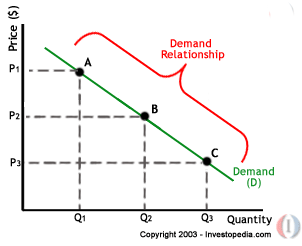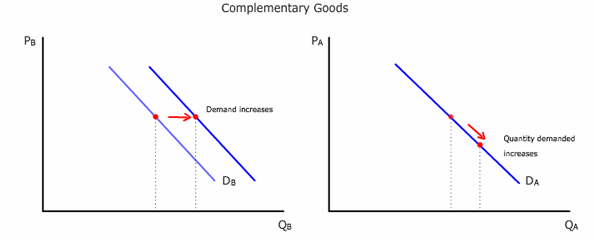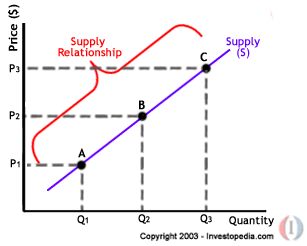|
K
What I know
|
W
What I want to know
|
L
What I learned
|
|
Write the information about
what you know in this space
|
Write the information about
what you want to know in this space.
|
After the completion of the
lesson or unit, write the information that you have learnt in this space.
|
|
-
The definition of complement and how being
complements will affect the prices of both goods.
-
Price
affects demand indirectly.
-
When
price increases/decreases, there will be a movement in the demand/supply
curve, NOT a shift.
|
-
How large the extent of effect that will
happen when prices of complements affect each other.
-
How price affects demand is shown.
|
-
I
learned that being complements, one good will be affected by the other as the
price, demand and supply of a good is affected.
-
A change in the price leading to a change
in the quantity demanded is shown by the movement along the demand curve,
assuming ceteris paribus.
-
Demand curve is affected by price and non-price
factors.
- Demand and supply can affect the movement/ shift in curves differently.
|
Monday, 5 May 2014
KWL on demand and supply
Demand and Supply
Product: Car
Demand for the product, in this case, the car, refers to the quantity of a good or service which consumers are willing and able to purchase at different price levels, over a specific time period, ceteris paribus. While supply for the product refers to the quantity of a good or service that sellers are willing and able to offer for sales at different price levels over a specific time period, ceteris paribus. Therefore in this case if the demand and supply of the car changes, it will lead to an effect on the new equilibrium price and quantity.
Price can affected directly to the quantity demanded of the car.

A, B and C are points on the demand curve. Each point on the curve reflects a inverse relationship between quantity demanded (Q) and price (P). So, at point A, the quantity demanded will be Q1 and the price will be P1, and so on. For example, when the price of the car falls from P1 to P2, the quantity demanded of the car will increase from Q1 to Q2. The demand relationship curve illustrates is illustrated by the downward movement of the graph, assuming ceteris paribus. However, if the price increase, quantity demanded of the car will decrease. To conclude, a change in the price leading to a change in the quantity demanded is shown by the movement along the demand curve, assuming ceteris paribus.
However, demand can also be affected by non-price factors. In this case, the non price factors expectations of future price of good and price of related goods will affect the demand of the cars.
 Similarly, when the price of petrol falls, the quantity demanded of petrol and cars will increase which is illustrated in the figure above.
Similarly, when the price of petrol falls, the quantity demanded of petrol and cars will increase which is illustrated in the figure above.



Demand for the product, in this case, the car, refers to the quantity of a good or service which consumers are willing and able to purchase at different price levels, over a specific time period, ceteris paribus. While supply for the product refers to the quantity of a good or service that sellers are willing and able to offer for sales at different price levels over a specific time period, ceteris paribus. Therefore in this case if the demand and supply of the car changes, it will lead to an effect on the new equilibrium price and quantity.
Price can affected directly to the quantity demanded of the car.

A, B and C are points on the demand curve. Each point on the curve reflects a inverse relationship between quantity demanded (Q) and price (P). So, at point A, the quantity demanded will be Q1 and the price will be P1, and so on. For example, when the price of the car falls from P1 to P2, the quantity demanded of the car will increase from Q1 to Q2. The demand relationship curve illustrates is illustrated by the downward movement of the graph, assuming ceteris paribus. However, if the price increase, quantity demanded of the car will decrease. To conclude, a change in the price leading to a change in the quantity demanded is shown by the movement along the demand curve, assuming ceteris paribus.
However, demand can also be affected by non-price factors. In this case, the non price factors expectations of future price of good and price of related goods will affect the demand of the cars.
Expectations of changes in income or price will cause changes in the demand for a good. For example, an expectation in an increase of a person's income may increase the person's current demand as the have more spending ability and thus able to consume more goods and services. Goods and services become more affordable and luxurious goods might also become a normal good because of the expectation of the raise in income.
Similarly, if consumers think that the price of a good might rise in the near future, they will consume more goods right now at it's current price. This is because they will want to consume the good when it is still relatively cheaper. For example, behaviour in the market for financial assets such as stocks and bonds are influenced by such expectations.
Thus, when incomes of consumers and future prices of goods are expected to rise, demand for the good will increase, shifting the demand curve to the right.
For example, cars. Certain brands of cars would be considered to be luxurious goods. However, when there is an expectation of the income in a society to increase, this brand of cars that were once considered luxurious become affordable or in other words, it becomes a normal good. Hence, the consumption of the cars will increase due to the expectation of the increase in income.
Consumers will also consider the price of the related good before buying the good they are interested in. In this case, consumers will consider the price of the complement for cars which is petrol. An increase in the price of petrol will lead to a decrease in the demand of cars because complements(petrol) are needed to be consumed together in order to derive satisfaction.
 Similarly, when the price of petrol falls, the quantity demanded of petrol and cars will increase which is illustrated in the figure above.
Similarly, when the price of petrol falls, the quantity demanded of petrol and cars will increase which is illustrated in the figure above.
Article on price of related goods: https://sg.finance.yahoo.com/news/increase-petrol-taxes-to-ease-coe-prices-of-smaller-cars--economist-123004170.html
Also, price can be directly affected by quantity supplied.

A, B and C are points on the supply curve. Each point on the curve reflects a direct relationship between quantity supplied (Q) and price (P). At point B, the quantity supplied will be Q2 and the price will be P2, and so on. This is illustrated by a downward movement along the supply curve from B to A. If the price increases, the quantity supplied of the good will increase, ceteris paribus, leading to an upward movement along the supply curve.
However, supply can also be affected by non-price factors. In this case, supply can be affected by the non-price factor, government policies. Rules and regulations set by the government will influence supply. For instance, when the government increase the price of the Certificate of Entitlement(COE) for the cars, the supply of cars will fall. Also, the most common policies set by the government that affect supply will be taxes (in this case road taxes).
Article of government policies: http://www.stcars.sg/guides-articles/coe-prices-set-to-rise-as-supply-dips-101101
A change in demand will cause a shift in the demand curve. Also, a change in supply will cause a shift in the supply curve.

For example in this figure above, an increase in both demand and supply will lead to a rightward shift of the demand and supply curves causing an indeterminate effect on the equilibrium price while equilibrium quantity will definitely increase causing a surplus.
In conclusion, both demand and supply will be affected by the price causing a movement of points in the demand/supply curve as well as the non price factors causing a leftward/rightward shift in the demand/supply curve(s).

Subscribe to:
Comments (Atom)